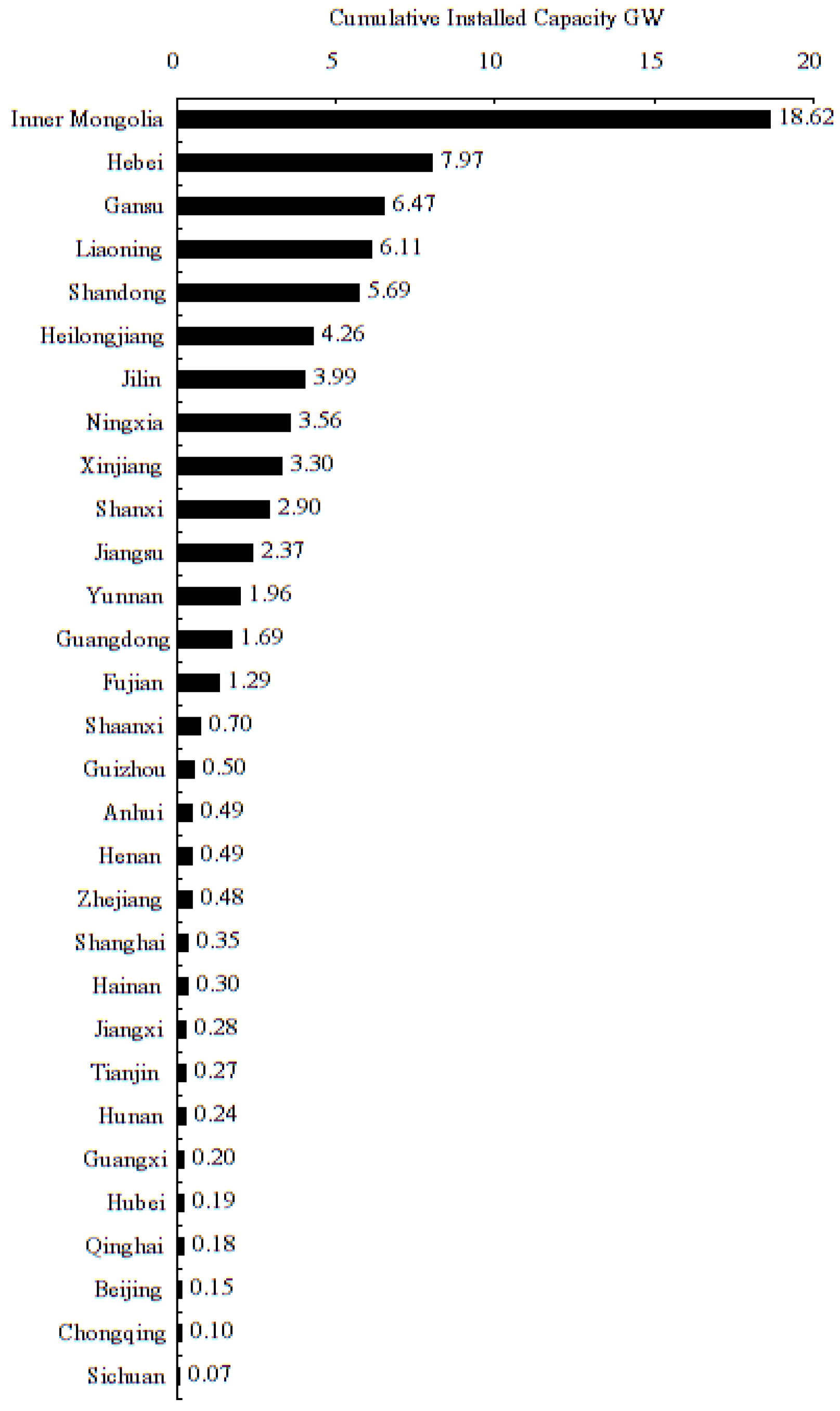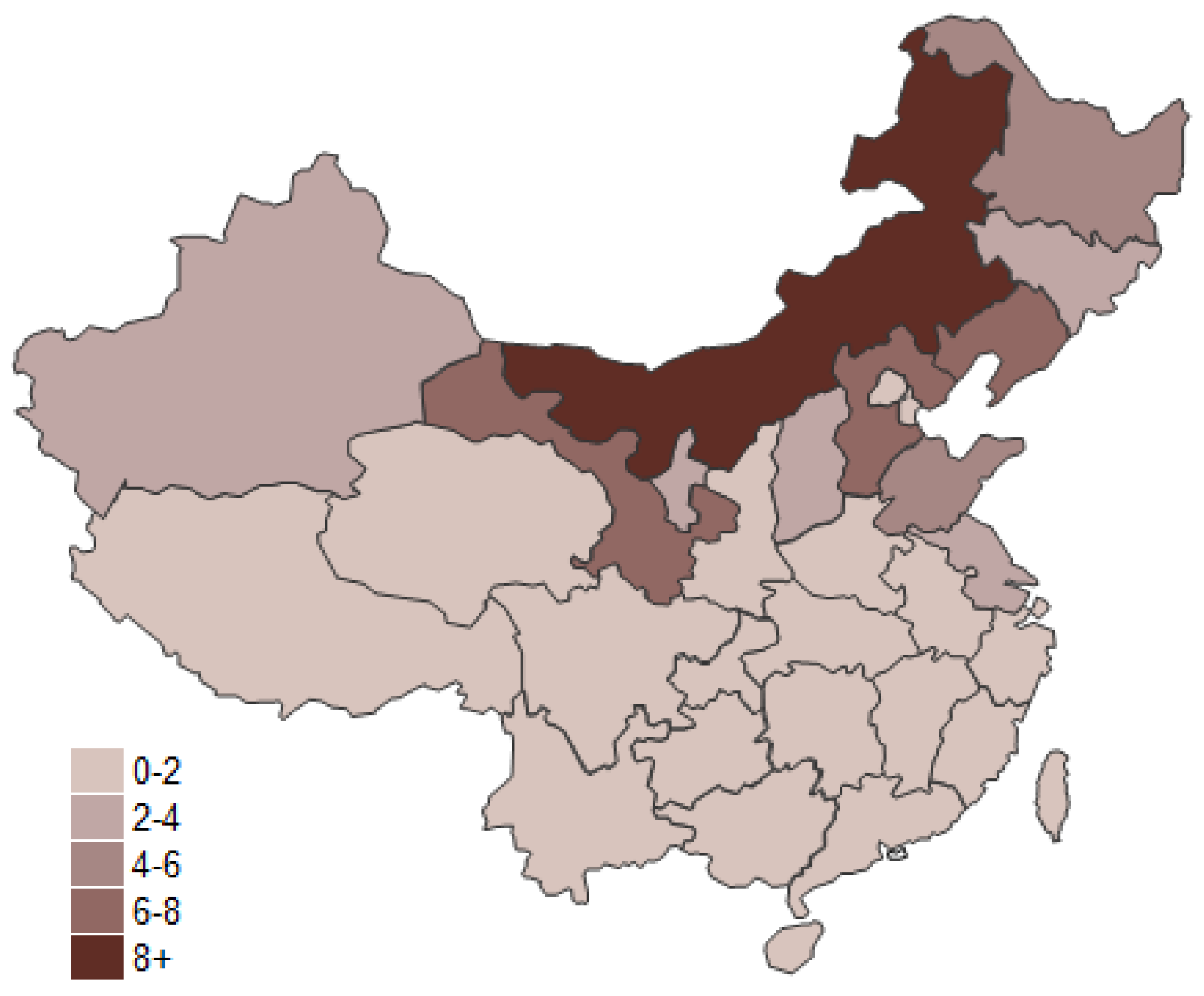Wind Power Development in China: An Assessment of Provincial Policies
Abstract
:1. Introduction
2. Methods
2.1. Wind Power in China: A Literature Review
2.2. Model
2.3. Dependent Variable
2.4. Provincial Wind Energy Policy and Energy Plans
2.5. Stringency of Environment Regulation
2.6. Pollution-Intensive Interest Groups
2.7. Economic Environment
2.8. Unexplored Wind Potential
3. Results and Discussion
3.1. Wind Energy Policy and Energy Plan
3.2. Energy and Emission Markets
3.3. Economic and Social Environments
4. Conclusions and Policy Implications
Acknowledgments
Author Contributions
Conflicts of Interest
References
- China Statistics Bureau. China Statistical Yearbook, 2012; China Statistics Bureau: Beijing, China, 2012.
- Zheng, S.; Yi, H.; Li, H. The impacts of provincial energy and environmental policies on air pollution control in China. Renew. Sustain. Energy Rev. 2015, 49, 386–394. [Google Scholar] [CrossRef]
- Wu, J.; Zhang, P.; Yi, H.; Qin, Z. What Causes Haze Pollution? An Empirical Study of PM2.5 Concentrations in Chinese Cities. Sustainability 2016, 8, 132. [Google Scholar] [CrossRef]
- Yi, H.; Feiock, R.C. Renewable energy politics: Policy typologies, policy tools, and state deployment of renewables. Policy Stud. J. 2014, 42, 391–415. [Google Scholar] [CrossRef]
- Yi, H.; Liu, Y. Green economy in China: Regional variations and policy drivers. Glob. Environ. Chang. 2015, 31, 11–19. [Google Scholar] [CrossRef]
- Zhao, X.; Li, S.; Zhang, S.; Yang, R.; Liu, S. The effectiveness of China’s wind power policy: An empirical analysis. Energy Policy 2016, 95, 269–279. [Google Scholar] [CrossRef]
- Liao, Z. The evolution of wind energy policies in China (1995–2014): An analysis based on policy instruments. Renew. Sustain. Energy Rev. 2016, 56, 464–472. [Google Scholar] [CrossRef]
- Shen, J.; Luo, C. Overall review of renewable energy subsidy policies in China—Contradictions of intentions and effects. Renew. Sustain. Energy Rev. 2015, 41, 1478–1488. [Google Scholar] [CrossRef]
- Fang, Y.; Li, J.; Wang, M. Development policy for non-grid-connected wind power in China: An analysis based on institutional change. Energy Policy 2012, 45, 350–358. [Google Scholar] [CrossRef]
- Zhang, S.; Andrews-Speed, P.; Zhao, X. Political and institutional analysis of the successes and failures of China’s wind power policy. Energy Policy 2013, 56, 331–340. [Google Scholar] [CrossRef]
- Wang, Z.; Qin, H.; Lewis, J.I. China’s wind power industry: Policy support, technological achievements, and emerging challenges. Energy Policy 2012, 51, 80–88. [Google Scholar] [CrossRef]
- Zhao, Y.; Hao, L.; Wang, Y. Development strategies for wind power industry in Jiangsu Province, China: Based on the evaluation of resource capacity. Energy Policy 2009, 37, 1736–1744. [Google Scholar] [CrossRef]
- Dai, Y.; Xue, L. China’s policy initiatives for the development of wind energy technology. Clim. Policy 2014, 15, 30–57. [Google Scholar] [CrossRef]
- Yang, M.; Patiño-Echeverri, D.; Yang, F. Wind power generation in China: Understanding the mismatch between capacity and generation. Renew. Energy 2011, 41, 145–151. [Google Scholar] [CrossRef]
- Lu, X.; McElroy, M.B.; Nielsen, C.P.; Chen, X.; Huang, J. Optimal integration of offshore wind power for a steadier, environmentally friendlier, supply of electricity in China. Energy Policy 2013, 62, 131–138. [Google Scholar] [CrossRef]
- Li, L.; Tan, Z.; Wang, J.; Xu, J.; Cai, C.; Hou, Y. Energy conservation and emission reduction policies for the electric power industry in China. Energy Policy 2011, 39, 3669–3679. [Google Scholar] [CrossRef]
- Lema, A.; Ruby, K. Between fragmented authoritarianism and policy coordination: Creating a Chinese market for wind energy. Energy Policy 2007, 35, 3879–3890. [Google Scholar] [CrossRef]
- Yang, M.; Nguyen, F.; de T’Serclaes, P.; Buchner, B. Wind farm investment risks under uncertain CDM benefit in China. Energy Policy 2010, 38, 1436–1447. [Google Scholar] [CrossRef]
- Zhao, X.; Wang, F.; Wang, M. Large-scale utilization of wind power in China: Obstacles of conflict between market and planning. Energy Policy 2012, 48, 222–232. [Google Scholar] [CrossRef]
- Liu, X. The value of holding scarce wind resource—A cause of over investment in wind power capacity in China. Energy Policy 2013, 63, 97–100. [Google Scholar] [CrossRef]
- Zhang, X.; Chang, S.; Huo, M.; Wang, R. China’s wind industry: Policy lessons for domestic government interventions and international support. Clim. Policy 2009, 9, 553–564. [Google Scholar] [CrossRef]
- Lam, J.C.K.; Woo, C.K.; Kahrl, F.; Yu, W.K. What moves wind energy development in China? Show me the money! Appl. Energy 2013, 105, 423–429. [Google Scholar] [CrossRef]
- Zhao, X.; Zhang, S.; Zou, Y.; Yao, J. To what extent does wind power deployment affect vested interests? A case study of the Northeast China Grid. Energy Policy 2013, 63, 814–822. [Google Scholar] [CrossRef]
- Ma, T.; Yang, H.; Lu, L. A feasibility study of a stand-alone hybrid solar–wind–battery system for a remote island. Appl. Energy 2014, 121, 149–158. [Google Scholar] [CrossRef]
- Ma, T.; Østergaard, P.A.; Lund, H.; Yang, H.; Lu, L. An energy system model for Hong Kong in 2020. Energy 2014, 68, 301–310. [Google Scholar] [CrossRef]
- Carley, S. State Renewable Energy Electricity Policies: An Empirical Evaluation of Effective-ness. Energy Policy 2009, 37, 3071–3081. [Google Scholar] [CrossRef]
- Sarzynski, A.; Larrieu, J.; Sharimali, G. The impact of state financial incentives on market deployment of solar technology. Energy Policy 2012, 46, 550–557. [Google Scholar] [CrossRef]
- Shrimali, G.; Jenner, S. The impact of state policy on deployment and cost of solar photovoltaic technology in the U.S.: A sector-specific empirical analysis. Renew. Energy 2013, 60, 679–690. [Google Scholar] [CrossRef]
- Yi, H. Clean energy policies and green jobs: An evaluation of green jobs in U.S. metropolitan areas. Energy Policy 2013, 56, 644–652. [Google Scholar] [CrossRef]
- Lyon, T.P.; Yin, H. Why Do States Adopt Renewable Portfolio Standards? An Empirical Investigation. Energy J. 2010, 31, 133–157. [Google Scholar] [CrossRef]


| Province | Year | Wind Energy Policies and Plans |
|---|---|---|
| Inner Mongolia | 2006 | Wind Power Development 11th “FYP” and Long-Term Objectives for 2020 |
| 2011 | Wind Power Development and Grid Integration 12th “FYP” | |
| Hebei | 2011 | Baihuapo Wind Power Project |
| Gansu | 2008 | Regulation for Wind Power Development and Construction Order |
| Jilin | 2008 | Interim Measures of Wind Power Project Preliminary Work |
| Ningxia | 2011 | Land Management Measures of Wind and Solar Photovoltaic Power Generation Project |
| Xinjiang | 2005 | Tax Exemption of Urban Land Using for Wind Power Plants |
| 2007 | Energy 11th “FYP” and Wind Power Development for 2020 | |
| Jiangsu | 2006 | Wind Power Development Plan from 2006 to 2020 |
| Yunnan | 2004 | The Power Industry 11th “FYP” and Long-Term Objectives for 2020 |
| Shanghai | 2008 | Interim Measures of Wind Power Project Preliminary Work |
| Jiangxi | 2007 | New Energy Development 11th “FYP” (wind power) |
| Policies and Plans | Provinces |
|---|---|
| Energy Development 11th “FYP” | Inner Mongolia, Hebei, Gansu, Ningxia, Xinjiang, Shanxi, Guangdong, Anhui, Henan, Shanghai, Hubei, Qinghai, Beijing, Sichuan, Shaanxi, Guizhou |
| Variables | Measures | Predicted Relationship | Data Sources |
|---|---|---|---|
| Wind capacity | Annual cumulative wind installation from 2001 to 2012 in five Ethnic autonomous regions, four centrally-controlled municipalities and 22 provinces | Dependent variable | Chinese Wind Energy Association, CWEA |
| Wind policy | Binary variable: “1”: with wind policy; “0” otherwise | - | Statistics office by province |
| Energy plan | Binary variable: whether a province has 11th “Five Year Plan” for Energy Development. “1”: with energy plan; “0” otherwise | - | Statistics office by province |
| Pollution fee | Pollution fee (tens of thousands RMB Yuan) | Control | China Statistical Yearbook [1] |
| SO2 emissions | SO2 emission (tens of thousands of tons) | Control | China Statistical Yearbook [1] |
| Per capita GDP | GDP (one hundred million RMB Yuan) divided by population year end (tens of thousands of persons) | Control | China Statistical Yearbook [1] |
| Unemployment rate | Unemployment rate (%) | Control | China Statistical Yearbook [1] |
| Unexplored wind potential | Unexplored theoretical potential (MW) | Control | China Statistical Yearbook [1] |
| Per capita income | Disposable Personal Income, DPI, (RMB Yuan) | Control | China Statistical Yearbook [1] |
| Population density | Population density (person per square kilometer) | Control | China Statistical Yearbook [1] |
| Variable | Observation | Mean | Standard Deviation | Min | Max |
|---|---|---|---|---|---|
| Wind capacity | 324 | 624.21 | 1919.82 | 0 | 18,623.8 |
| Wind policy | 324 | 0.15 | 0.36 | 0 | 1 |
| Energy plan | 324 | 0.27 | 0.44 | 0 | 1 |
| Pollution fee | 324 | 46,086.95 | 45,800.11 | 357 | 287,343 |
| SO2 emissions | 324 | 72.14 | 46.35 | 0.1 | 200.30 |
| Per capita GDP | 324 | 2.25 | 1.71 | 0.29 | 9.13 |
| Unemployment rate | 324 | 3.71 | 0.69 | 1.2 | 6.9 |
| Unexplored wind potential | 324 | 118,278.8 | 182,452.2 | 7849.3 | 786,868.2 |
| Per capita income | 324 | 13,311.02 | 6348.30 | 5267.42 | 40,188.34 |
| Population density | 324 | 2121.96 | 1393.40 | 56 | 6307 |
| Variables | Coefficient | Standard Errors |
|---|---|---|
| Wind policy | 0.701 *** | 0.269 |
| Energy plan | 0.485 ** | 0.232 |
| Pollution fee | 0.515 ** | 0.239 |
| SO2 emissions | −0.844 ** | 0.369 |
| Per capita GDP | −0.280 | 0.283 |
| Unemployment rate | 0.025 | 0.202 |
| Unexplored wind potential | −6.779 | 4.255 |
| Per capita income | 0.346 *** | 0.063 |
| Population density | 0.078 | 0.078 |
| Constant | 70.802 | 46.073 |
| Observation | 324 | - |
| Province Fixed Effect | Yes | - |
| Year Fixed Effect | Yes | - |
| R-squared (within) | 0.772 | - |
© 2016 by the authors; licensee MDPI, Basel, Switzerland. This article is an open access article distributed under the terms and conditions of the Creative Commons Attribution (CC-BY) license (http://creativecommons.org/licenses/by/4.0/).
Share and Cite
Zhang, X.; Wang, D.; Liu, Y.; Yi, H. Wind Power Development in China: An Assessment of Provincial Policies. Sustainability 2016, 8, 734. https://doi.org/10.3390/su8080734
Zhang X, Wang D, Liu Y, Yi H. Wind Power Development in China: An Assessment of Provincial Policies. Sustainability. 2016; 8(8):734. https://doi.org/10.3390/su8080734
Chicago/Turabian StyleZhang, Xiaogang, Dong Wang, Yuanhao Liu, and Hongtao Yi. 2016. "Wind Power Development in China: An Assessment of Provincial Policies" Sustainability 8, no. 8: 734. https://doi.org/10.3390/su8080734





